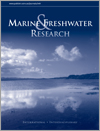Estimates of total catches, not just landings, are key inputs to population assessments; however, this information is scarce for discarded species. We quantified annual shark and ray discards from the main shark fisheries of Western Australia. These catches are small given the low post-release mortality of most discarded species.

Marine and Freshwater Research
Volume 73 Number 3 2022
In this study we used the feed-forward neural network to forecast water consumption in two countries along the Nile River (Egypt and Kenya). The study breaks down the different factors affecting water use (i.e. climate change, booming population growth and intensive urbanisation along the Nile River) because the proper planning and management of transboundary resources is critical and necessary.
MF21118 Abstract | MF21118 Full Text | MF21118PDF (1.4 MB) Open Access Article
This study assessed the role the endangered soft coral Dendronepthya australis plays in temperate ecologies, both as a food source and a habitat for other organisms. Invertebrates associated with the coral often fed exclusively on its tissues rather than other estuarine sources, but no large organisms fed on the corals. Numerous commercially important species were associated with soft coral habitats.
MF21155 Abstract | MF21155 Full Text | MF21155PDF (982 KB) Open Access Article
The objective of this study was to investigate the phylogenetic relationships among lineages of A. lobidens s.l. throughout their geographical distribution and identifying possible morphological characteristics that support the lineages from this combined dataset. Analyses indicated the occurrence of at least nine lineages within the A. lobidens species complex.
Morphological, molecular and ecological comparisons identify a Japanese foraminifer Trochammina hadai in a south-west Australian estuary adjacent to Bunbury Port. Although common here, the species has not been found elsewhere in Australia. Transportation may have been via ballast water in shallow-draught woodchip ships. T. hadai, easily observed in sediment samples, may be an indicator for the presence of other exotic species.
MF21254 Abstract | MF21254 Full Text | MF21254PDF (4.7 MB) | MF21254Supplementary Material (300 KB) Open Access Article
MF21127By-catch-associated demographics of two threatened seahorses from the south-east coast of India
The population dynamics of two threatened seahorse species, Hippocampus kuda and H. trimaculatus, from the south-east coast of India showed their high vulnerability to fishing pressure. Even as ‘incidental catch’, these threatened species are vulnerable to overfishing, and an imminent collapse, unless species-specific conservation guidelines are developed and implemented.
MF21094Growth, mortality, and reproduction of the oblique-banded snapper (Pristipomoides zonatus) in Guam
Deep-water snapper fisheries are important commercial, recreational and subsistence fisheries. To fill a regional life-history gap for Pristipomoides zonatus, a comprehensive life-history assessment was undertaken, which included age, growth, mortality and reproduction, from samples collected from Guam. Our results expand knowledge on Pristipomoides life history (fast early growth, moderately long-lived, high productivity).
The blue swimmer crab (Portunus armatus, BSC) is an important species in fisheries throughout the coastal waters of the Indo-Pacific region, but BSC reproduction is poorly understood in south-eastern Australia. We found that female crabs in south-eastern Australia were larger and produced bigger egg batches in cooler waters, and individual reproductive output peaked at a mean monthly temperature of ~24°C. Quantifying drivers of reproductive biology is important in examining the impact of environmental variation on population productivity and recruitment.
MF21191 Abstract | MF21191 Full Text | MF21191PDF (728 KB) | MF21191Supplementary Material (285 KB) Open Access Article
MF21200Feeding ecology of juvenile Pacific bluefin tuna Thunnus orientalis in the Sea of Japan
 , Ken-ichi Nakamura, Atsushi Nishimoto
, Ken-ichi Nakamura, Atsushi Nishimoto  , Atsushi Tawa, Taketoshi Kodama
, Atsushi Tawa, Taketoshi Kodama  , Nobuaki Suzuki, Hiroshi Ashida
, Nobuaki Suzuki, Hiroshi Ashida  and Hiroshige Tanaka
and Hiroshige Tanaka 
The feeding ecology of juvenile Pacific bluefin tuna (PBF) Thunnus orientalis in the Sea of Japan was examined. Stomach content analysis showed that fish and cephalopods were main prey items. In particular, the feeding on fish would be essential to achieve a high growth rate and would therefore be associated with the survival of juvenile PBF before recruitment.
This study explored the nutritional components and reproductive cycle of a novel gastropod resource in Atlantic Patagonia. The optimal quality of this gastropod for human consumption is during the austral autumn, when the gastropods have a high bodyweight and high protein content. This paper not only provides information on the nutritional components of an edible Patagonian marine gastropod, but also contributes to generating management strategies for this artisanal fishery resource.
The combined use of chemical and biological indices is an efficient way to determine ecological status in highly dynamic coastal ecosystems. Thus, in this study we analysed trace elements and macroinvertebrates in coastal marine surface sediment samples facing a river estuary. The ecological status of the stations studied is considered good.
MF21044Trophic interactions between native and exotic cichlids in a shallow tropical estuary (Lake Vembanad, India)
 , Chelapurath Radhakrishnan Renjithkumar, Giri Bhavan Sreekanth
, Chelapurath Radhakrishnan Renjithkumar, Giri Bhavan Sreekanth  , Rajeev Raghavan
, Rajeev Raghavan  , Kutty Ranjeet, Mahadevan Harikrishnan and Balakrishnan Madhusoodana Kurup
, Kutty Ranjeet, Mahadevan Harikrishnan and Balakrishnan Madhusoodana Kurup
Feeding ecology and seasonal diet variation between a non-native (Oreochromis mossambicus) and two native (Etroplus suratensis and Pseudetroplus maculatus) cichlids in a tropical estuary showed high dietary similarity and food resource partitioning. Trophic interactions among the three cichlids showed that the two, large growing species (E. suratensis and O. mossambicus) share similar food resources, whereas the smaller species (P. maculatus) considerably alters its food preference to avoid competition.



